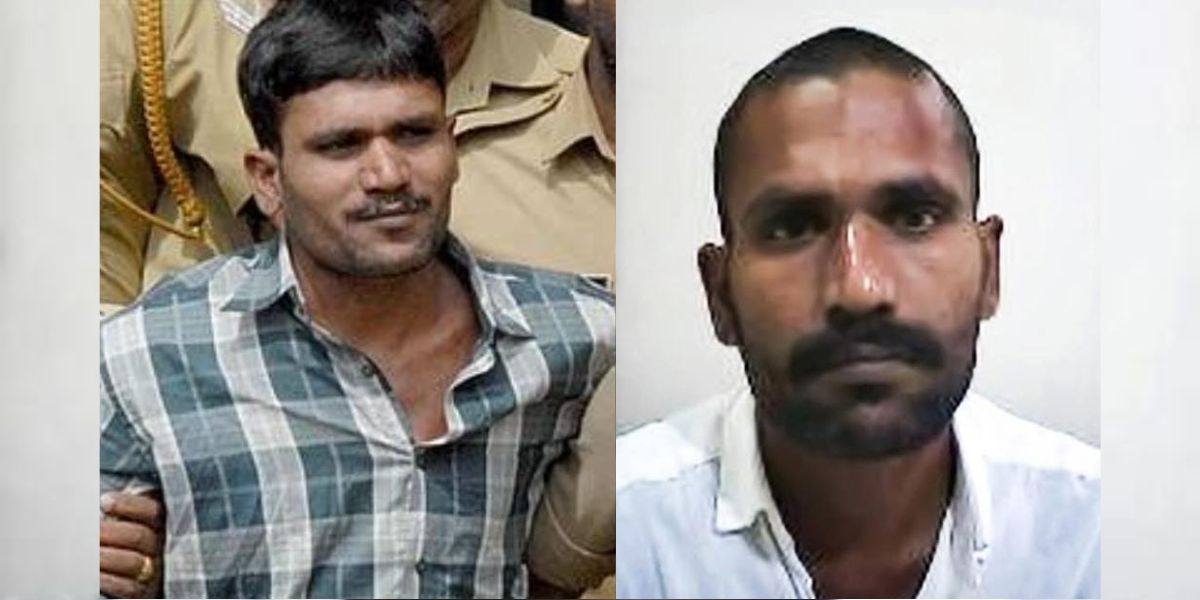Govindachamy, who was in the 10th block of Jail, escaped by cutting the jail bars and climbing over the wall using a rope made from cloth.
Published Jul 26, 2025 | 12:51 PM ⚊ Updated Jul 26, 2025 | 2:47 PM

A file photo of Govindachamy and a recent image.
Synopsis: Govindachamy, convicted in the 2011 Soumya case, escaped Kannur Central Jail on 25 July but was found in a nearby well. Following a major security lapse, he was moved to Viyyur’s high-security prison and placed in solitary confinement. Victim Soumya’s mother expressed fear and suspicion, demanding a full investigation, alleging possible inside help in the escape.
Prison escapee Govindachamy, who staged a dramatic jailbreak from Kannur Central Jail on Friday, 25 July, has been shifted to the high-security prison in Viyyur under tight police security. It’s said he will now be kept in solitary confinement.
Govindachamy, who was found hours later inside a well in an office building located 4 km from the prison, was moved following the admission of a serious security lapse by jail authorities.
The prison chief acknowledged the breach, leading to the suspension of four officials. Govindachamy, who was in the 10th block of Jail, escaped by cutting the jail bars and climbing over the wall using a rope made from cloth.
The transfer was carried out early in the morning on Saturday, 26 July, in the presence of senior officers, using a police Rapid Action Force vehicle. Security was tightened along the entire route from Kannur to Viyyur, with restrictions imposed across multiple police station limits.
Upon arrival at Viyyur, Govindachamy was placed in a specially-prepared solitary cell. The high-security block, which currently houses only 125 inmates despite a capacity of 536, is equipped with 4.2-meter-high cells, CCTV surveillance, and strict isolation protocols.
Inmates in solitary confinement are not permitted to see or speak to others and must eat their meals inside the cell.
A 6-meter-high wall spanning 700 meters has been constructed around the jail to enhance security.
Govindachamy, who has been in prison for 15 years, is said to have told police he had made three prior attempts to escape. “No parole, no good food… I was tired of prison life,” he reportedly said. He also alleged he was never granted parole and claimed, “I only committed rape.”
Meanwhile, Kerala Chief Minister Pinarayi Vijayan, on Saturday has ordered a high-level, comprehensive investigation into the incident.
The state government has appointed retired Kerala High Court Judge Justice C N Ramachandran Nair and former State Police Chief Jacob Punnoose to jointly head the special probe into the serious security lapse.
The decision was taken at an emergency high-level meeting convened by the chief minister on Saturday.
The meeting was attended by top officials, including Chief Secretary Dr A Jayathilak, State Police Chief Rawada Chandrasekhar, Additional Chief Secretary (Home) Bishwanath Sinha, PWD Secretary K Biju, Prisons Chief Balram Kumar Upadhyay and Additional DGP (Intelligence) P Vijayan.
Terming the incident “extremely serious,” the chief minister said it pointed to deep-rooted issues in prison management and required a detailed investigation, strict action, and long-term reforms.
In addition to the ongoing police and departmental inquiries, the special inquiry led by Justice Nair and Jacob Punnoose is expected to look into possible systemic failures and recommend corrective measures.
The chief minister also announced plans to establish a new central jail to manage the rising number of inmates. Land for the same will be explored in the Kottayam and Pathanamthitta districts.
Vijayan has instructed that all ongoing investigations into the jailbreak be completed without delay, with accountability fixed at all levels.
Govindachamy is a native of Virudachalam in Tamil Nadu and is also known as Charley Thomas. He also has other cases against him in Tamil Nadu, including theft.
His conviction stems from the brutal attack on Soumya, a young woman who was assaulted on a moving passenger train on 1 February 2011.
She had boarded the women’s compartment on a train from Ernakulam to Shoranur, where she was attacked by Govindachamy, who then reportedly threw her off the train and later raped her.
Soumya succumbed to her injuries on 6 February 2011 at the Thrissur Medical College Hospital. The Thrissur Fast Track Special Court sentenced Govindachamy to death on 11 November 2011. However, the Supreme Court commuted the death sentence in September 2016.
Sumathi, the mother of Soumya, responded to the incident with deep concern. “I was terrified when I heard the news. If he had remained outside, how many more girls’ lives would have been at risk?”
She expressed her gratitude to those who acted swiftly to capture him, but also raised serious doubts.
“It’s suspicious, how could a man with a disability climb the high walls of a central jail on his own? If he isn’t moved to a more secure cell, there’s a real chance he could try to escape again. I strongly believe he had help from inside. A thorough and impartial investigation is absolutely necessary,” she said.
(Edited by Sumavarsha, with inputs from Dileep V Kumar)
